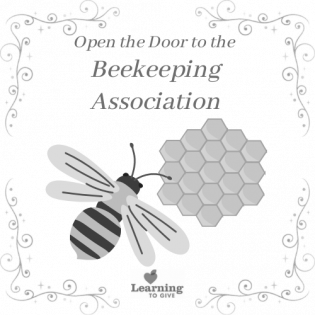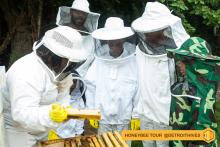Open the Door to a Beekeeping Association
The "Open Doors to Your Community" project is a virtual door that guides young people to the actual door of local resources so they can learn about their community, take action, and build connections and understanding of their roles in the community.
What Is the Purpose of a Beekeeping Association?
Bees are essential to a healthy environment. They pollinate flowers so we have a variety of flowers, plants, and foods. A beekeeper not only takes care of bees, they also help individuals and communities set up sustainable beehives. They educate people on the importance of bees and involve youth in learning about habitats, financial sustainability, and the importance of being part of a supportive community.Meet a Beekeeper
In this brief video, we meet Timothy Paul Jackson. He tells us about the beekeeping association Detroit Hives. Their mission is to improve underserved communities for people and pollinators. They transform vacant lots into educational apiaries or pollinator green spaces. They maintain 1500 bee colonies in the SE Michigan region. They also have a program for youth that teaches bee care and conservation initiatives that address social and environmental impacts. Youth also engage in their community as volunteers and advocates.
Contact Your Local Center
Look up the contact information for the beekeepers or apiaries in your community where you can learn about their services. Call to set up a phone or in-person interview. Tell them you'd like to learn more about the work of beekeeping and ways you can get involved or volunteer to help their mission. Ask for 30 minutes or an hour of their time. The Interview Script linked here and below can help you make the call.
Interview Questions
These questions can help you learn about your community and ways you can get involved.
- What is the main purpose of a beekeeping association or education center? This may be its mission or vision.
- What are some challenges that we face if bees don't thrive? What are the different reasons bees don't do well?
- What are some things people can do to attract bees to their neighborhood?
- Should people be afraid of bees? What should they do if they see one?
- What can a young person do to participate in the work of a beekeeping association?
Take Action in Your Community
Reflect on the needs of the apiary. What can you help them do? Your voice and time matter. The resources below can help you plan a project.
The best service-learning projects guide us to gain and use knowledge, are led by youth voice and passion, address a need, and develop connections with local resources over time.
 Learning to Give Issue Area Toolkits include background on the issue, community connections, lessons and activities, project ideas, and planning guides. Check out the Humans and the Environment toolkit. This lesson about Beneficial Bees teaches more about bees.
Learning to Give Issue Area Toolkits include background on the issue, community connections, lessons and activities, project ideas, and planning guides. Check out the Humans and the Environment toolkit. This lesson about Beneficial Bees teaches more about bees.
 Learning to Give Service Sparks guides provide directions for generous actions that encourage youth voice and promote the common good. Young people can plant a Bee and Butterfly Garden or make an Advocacy Poster to raise awareness of the need to care for bees.
Learning to Give Service Sparks guides provide directions for generous actions that encourage youth voice and promote the common good. Young people can plant a Bee and Butterfly Garden or make an Advocacy Poster to raise awareness of the need to care for bees.
 Learning to Give Literature guides combine selected literature with thought-provoking discussions and activities that teach about giving and civic engagement. Read aloud a picture book to a younger child or a retirement home buddy and talk about the community themes. The picture book Each Living Thing challenges readers to notice living things and care for them.
Learning to Give Literature guides combine selected literature with thought-provoking discussions and activities that teach about giving and civic engagement. Read aloud a picture book to a younger child or a retirement home buddy and talk about the community themes. The picture book Each Living Thing challenges readers to notice living things and care for them.
More about Bees
Fun Facts:
- A worker bee produces less than a teaspoon of honey in her lifetime.
- Honey gets different flavors from the different flowers bees get nectar from.
- While getting nectar to make honey, the bee picks up pollen and carries it on their hind legs to another flower.
- Bees fly about 20 miles per hour.
- Male bees are called drones.
- Bees are important because they pollinate crops that feed people.
What You Can Do!
- Teach people how to respond when they see a bee.
- Plan colorful flowers year-round at your house. Plant flowers on your windowsill to watch the bees come and go.
- Tell your friends about the importance of bees.
- Tell your community to make wild spaces bee-friendly.
- Don't use chemical fertilizers around your house that can kill bees.
- Make a bee bath so they can rest on a stone and get a drink.
- Learn about bees and take care of a beehive.
- Meet with local growers to learn their perspective of how bees impact their crop harvest.

